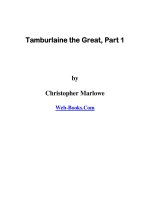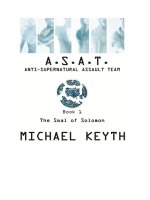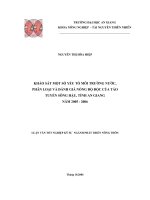Maritime search planning part 1 MILSAR 1 2005
Bạn đang xem bản rút gọn của tài liệu. Xem và tải ngay bản đầy đủ của tài liệu tại đây (1.52 MB, 15 trang )
Maritime Search Planning
Part 1
Objectives
• Maritime search planning theory and
various models
• Worksheet method of drift planning
including a demonstration
• Individual exercises using the worksheet
• Demonstration of Net Water Movement
References
National SAR Manual - Chapter 4
IAMSAR Manual - Chapter 4
Search Planning Steps
• Evaluate the situation including results of previous
searches (intelligence)
• Last Known Position (LKP) and error
• Estimate the movement of survivors and errors
(scenarios)
• Calculate datum and the search area for a
particular time
• Obtain and allocate resources
• Rescue plan
Datum
“A geographic point, line or area used as a
reference in search planning”
Time specific eg 210000 UTC December
Possibility Area
“The possibility area is the area in which
the missing craft may be located.”
• Usually too large to search
• A useful boundary for considering
intelligence, broadcasts and incoming
reports
• Maximum limit of fuel and subsequent drift
Possibility Area
“The possibility area is the area in which
the missing craft may be located.”
Probability Area
“The area in which the missing craft and/or
survivors are most likely to be found taking
into account possible errors in the
navigation of the missing craft and the
search craft, together with an allowance for
any water movement and a safety factor.”
Probability Area
Initial Search Planning
• Initial SAR response – simple and quick to
cover the most likely area.
• Resources may be limited.
• Search light may be limited.
• Time Frame for Survival – Software using
SST, sea state, clothing. Combine with
expert medical advice.
• Don’t forget the rescue option.
Formal Search Planning
•
•
•
•
•
•
•
Initial SAR response unsuccessful.
Intelligence picture more complete.
Environment data obtained and applied.
Mathematical calculation of the search area.
Wide area grid searches, plan 2 – 3 per day.
More resources acquired and allocated.
Don’t forget the rescue option.
Search Planning Models
• Coastal Method
• Mathematical Oceanic Models in National
SAR Manual* and IAMSAR Manual
• Net Water Movement – RCC Australia’s
computerised calculation system employing
wind, current, tidal and bathymetry data.
Coastal Search Planning
• Suitable for initial SAR response within
25 nm of coast and under 100 metres depth.
• Use within first 6 hours of distress situation
in lieu of formal oceanic model.
• Creates an initial search area that applies
errors to LKP and navigation of search unit
plus applied drift (if known).
Coastal Search Planning
•
•
•
•
•
•
E = √(X2 + Y2)
E = √(52 + 12)
E = √ 26
E = 5.099 nm
E = (5.099)(1.1)
E = 5.6 rounded up to 6 nm
from Appendix J-1 and J-2
Maritime Search Planning
End of Part 1









